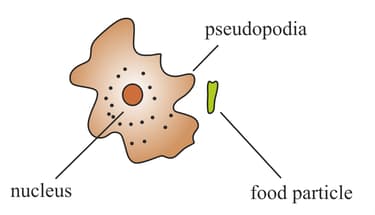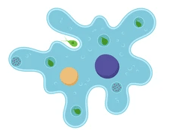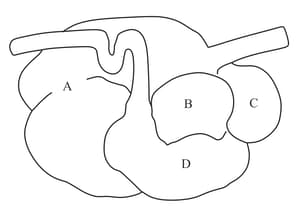Embibe Experts Solutions for Chapter: Nutrition in Animals, Exercise 1: Exercise
Embibe Experts Science Solutions for Exercise - Embibe Experts Solutions for Chapter: Nutrition in Animals, Exercise 1: Exercise
Attempt the free practice questions on Chapter 2: Nutrition in Animals, Exercise 1: Exercise with hints and solutions to strengthen your understanding. THINK ABOVE AND BEYOND SCIENCE PRACTICE BOOKS solutions are prepared by Experienced Embibe Experts.
Questions from Embibe Experts Solutions for Chapter: Nutrition in Animals, Exercise 1: Exercise with Hints & Solutions
Food that hasn't been fully digested enters a person's body through the long, narrow organ A. Organ A receives the secretions of two glands: liver and pancreas. The liver secretes a greenish-yellow liquid B which is normally stored in the organ C. Identify organ A, C and also liquid B.
A unicellular organism X having no fixed shape ingests a food particle by forming temporary finger-like projections Y. The food particle is engulfed with a little surrounding water to form a temporary sac-like structure Z inside it. Enzymes from the surrounding cytoplasm enter into Z and break down food into small and soluble molecules by chemical reactions. The digested food is absorbed directly into the cytoplasm by the process of diffusion. Identify X, Y and Z.
Amoeba uses finger-like projections to capture food particles. The picture shows the first step of the process.

Identify from the options, which is the next and last steps of capturing food.
Amoeba is a microscopic single-celled organism found in pond water. It pushes out one, or more finger-like projections, called pseudopodia or false feet for movement and capture of food. Amoeba feeds on some microscopic organisms. When it senses food, it pushes out pseudopodia around the food particle and engulfs it. The food becomes trapped in a food vacuole.

It is said food vacuole in Amoeba is similar to the small intestine of human beings. Do you agree? Explain.
It’s common for babies to throw up sometimes after feeding milk. Their new digestive system is still learning what to do with all the milk coming down into their tummy. In most cases, we have often seen that an infant child after feeding on milk vomits out something like curd. How does this happen? Is there any mechanism in babies' digestive system where milk is converted to curd? Explain your answer.
Astronauts while in space sometimes take food upside down. Will the food go through the alimentary canal? Explain your answer.

The above diagram represents stomach of ruminants. Identify A,B, C and D. What will happen if A will not function properly in ruminants?
When a person puts food in his mouth, then teeth cut it into small pieces, chew and grind it. The glands A in the mouth secrete a substance B which is mixed with the food by the tongue. The substance B contains an enzyme C which starts the digestion of food in the mouth. The slightly digested food from the mouth goes down a tube called oesophagus and subsequently passes through different organs and glands for the digestion process.
What is (i) gland A (ii) substance B, and (iii) enzyme C?
